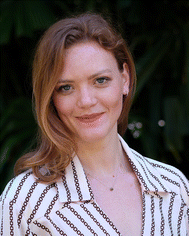Materials Horizons Emerging Investigator Series: Dr Katharina Ehrmann, Institute for Applied Synthetic Chemistry, Technische Universität Wien, Austria
Abstract
Our Emerging Investigator Series features exceptional work by early-career researchers working in the field of materials science.
Dr Katharina Ehrmann is teamleader of the Additive Manufacturing Team at TU Wien, pursuing Habilitation. She is working on broadening the processing window of and rethinking the chemistry behind light-based additive manufacturing of polymers to obtain high-performance parts with functionality and has recently been awarded the Elise Richter Fellowship by the Austrian Science Fund (FWF) to pursue new methodologies for multi-material 3D printing. She studied chemistry at the University of Innsbruck (Austria) and the University of Edinburgh (UK). During her PhD in the group of Prof. Robert Liska at TU Wien (Austria) Dr Ehrmann developed self-reinforcing thermoplastic polyurethanes for tissue engineering applications. She then became a postdoctoral research fellow in Prof. Christopher Barner-Kowollik’s group at the Queensland University of Technology (QUT, Australia) in 2021, where she worked on wavelength-resolved photopolymer-networks and has remained a visiting research fellow at QUT since her return to TU Wien in 2023. She is also a member of the International Younger Chemists Network of IUPAC and elected Member-at-Large in the American Chemical Society’s Polymer Science, Materials, and Engineering Division. Dr Ehrmann has received several prestigious prizes and fellowships such as the Dr Maria Schaumayer Dissertation Prize, Vienna Center in Engineering and Medicine Dissertation Prize, Christiana Hörbiger Prize for the international mobility of young researchers, the CAS Future Leaders Fellowship, the FFG Female Innovator Fellowship and most recently the Dr Ernst Fehrer Prize for her research on multi-material printing.
Read Katharina Ehrmann’s Emerging Investigator Series article ‘Rapid 3D printing of unlayered, tough epoxy–alcohol resins with late gel points via dual-color curing technology’ ( https://doi.org/10.1039/D4MH01261E ) and read more about her in the interview below:
MH: Your recent Materials Horizons Communication demonstrates rapid 3D printing of unlayered, tough epoxy–alcohol resins with late gel points via dual-color curing technology. How has your research evolved from your first article to this most recent article and where do you see your research going in future?
KE: My first article related to additive manufacturing (before that I worked on homogeneous artificial photosynthesis and synthetic small-diameter vascular grafts) introduced a non-migrating chain-transfer agent in order to create more homogeneous and tough photopolymers (https://doi.org/10.1039/D0PY01746A). At the time, we changed the components of the formulation to change the outcome of the printing process. In recent research, including this article, I am not only focused on the monomers but especially on the parameters of the printing process in order to change the network architecture and thereby material properties. Additionally, my focus has shifted from creating mechanically well-performing materials for 3D printing to accessing new, unprecedented material properties in photopolymers.
MH: What aspect of your work are you most excited about at the moment?
KE: I am currently very interested in light-based multi-material 3D printing. Printing different material properties within one object is very difficult and at the same time so important for functionality. I find it fascinating to look at the narrow window of printing conditions and see how they can be skewed in order to vary the chemistry happening inside the printer such that diverse material properties can be produced from the same set of monomers. It turns out that this very applied research question creates a lot of room for fundamental chemistry research!
MH: In your opinion, what are the most important questions to be asked/answered in this field of research?
KE: Aside from the just mentioned multi-material challenge, I am fascinated by research around creative photoinitiation strategies, as shown in our current article in Materials Horizons. Furthermore, I like the question of how we can intentionally create microstructures in photopolymers, a historically very unstructured type of polymer network.
MH: What do you find most challenging about your research?
KE: That so many different types of chemistry keep coming to the center of our attention to answer our questions around creating functional materials – it really requires us to look into very different chemical concepts for each project. When you then require new functionalities from your printer to realize these chemical concepts, the research quickly becomes interdisciplinary e.g. because it requires us to look into new analytical methods for the materials, or new engineering challenges for the printer.
MH: In which upcoming conferences or events may our readers meet you?
KE: I will for example be at the Dynamic Polymer Networks Conference (https://dpn2025.com/speakers/), the 2025 Polymers Gordon Research Conference (https://www.grc.org/polymers-conference/2025/), and a brand new and exciting conference around 3D printing, Additiv Manufacturing of Soft Materials (https://3dam-conference.com/speakers/).
MH: How do you spend your spare time?
KE: This is a little bit dependent on the time of the year. At the moment, I like to paint. In summer, I can usually be found on and in the water, either stand-up paddling or swimming.
MH: Can you share one piece of career-related advice or wisdom with other early career scientists?
KE: There is no harm in asking a question! I found that the more questions I ask, the better I become at it. And the better your questions are, the more exciting your research gets. Aside from asking questions in research, I have found that the answer to your questions will more often be “yes” than “no” – if you gather the courage to ask in the first place.
| This journal is © The Royal Society of Chemistry 2025 |

